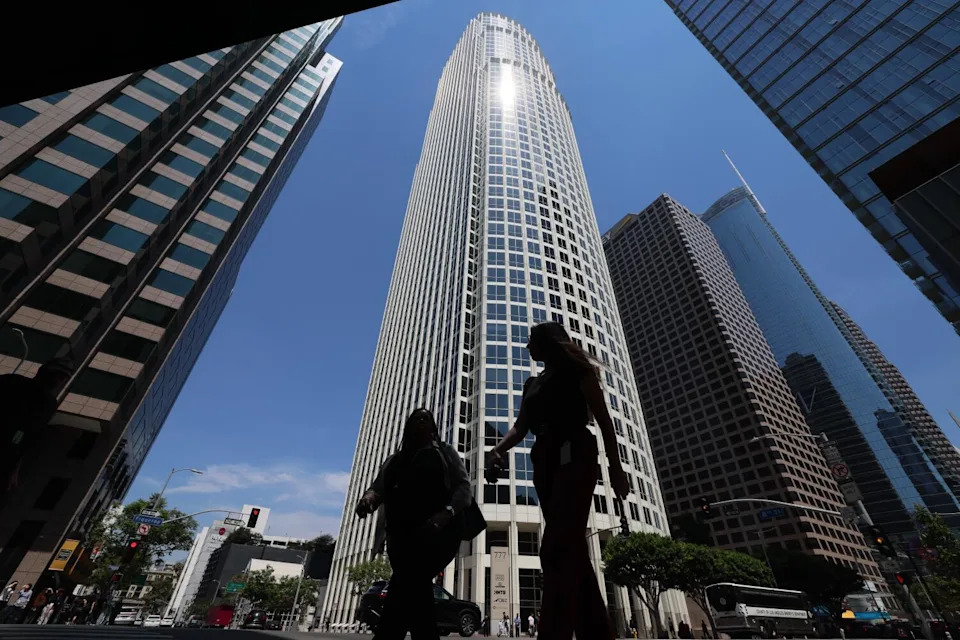
Even as bosses across the country report a jump in the number of people returning to the office, attendance in California remains less than half of what it used to be.
A recent survey shows that managers' push to get workers back in the office is bearing fruit, but executives would still like to see people at their desks more often. A different dataset demonstrates that much of the lag is due to California.
Companies are stepping up enforcement of their attendance policies even as many workers try to avoid the daily routine of commuting and clocking in, real estate brokerage CBRE found in a national survey of office tenants.
Companies made "significant" progress in the last year in moving toward their office-attendance goals and enforcing their attendance policies, moving closer to cementing their long-term work guidelines than at any time since the COVID-19 pandemic, CBRE said.
The annual survey found that 72% of the companies surveyed have met their attendance goals, up from 61% the previous year.
“Companies have made significant progress on establishing a new baseline for work habits and office attendance after five years of adapting to hybrid work,” said Manish Kashyap, CBRE’s global president of leasing.
Still, a separate indicator released Tuesday shows how office visits are stuck below the national average in California.
The Los Angeles and San Francisco metropolitan areas still have some of the lowest office attendance in the country, according to the latest data from Kastle Systems, which provides key-card entry systems used by many companies and tracks patterns of workers’ card swipes.
Business in the regions is dominated by the entertainment and tech companies, which can often be more freewheeling because much of the work is done alone and on computers that could be located anywhere.
Bosses in Los Angeles tend to be more flexible when it comes to remote work in part because commutes can be so long there, said Mark Ein, Kastle's executive chair. "It's just harder to get to the office."
In the week that ended Aug. 20, the average office population was 48.3% of full occupancy in Los Angeles, Kastle said Tuesday. Attendance was 41.8% in San Francisco and 49% in San Jose.
That's well above the lows below 20% during the pandemic, but still behind places including New York and Chicago and far behind cities in Texas, which had more than 60% attendance.

In the CBRE annual survey, the most notable change was in the level of enforcement of back-to-office policies. The share of companies monitoring attendance jumped to 69% this year from 45% last year. Those enforcing attendance policies rose to 37% from 17%.
Bosses said they want to see even more people in the office. Surveyed companies reported that they want employees in the office an average of 3.2 days per week. Actual attendance is close to that at 2.9 days a week.
The fact that people aren't in the office every day creates vibe issues for some managers who are trying to recapture the buzz their workplaces had before the pandemic.
More than half of organizations reported that a lack of office vibrancy on non-peak attendance days is a central challenge. Uneven attendance patterns create peaks and valleys throughout the week, something managers say makes it difficult for them to provide a consistent experience for employees.
"We've seen Los Angeles lag behind other cities in getting people back to the office," CBRE real estate broker Jeff Pion said. "I would hypothesize that we didn't have as many people in the office five days a week, even pre-COVID, just because of the nature of the work that takes place in Los Angeles."
The data suggest that better offices are more likely to have more people. Average occupancy in what Kastle considers the best quality offices is higher than at lower quality offices.
"If someone is paying a lot for their office space, they're going to want people to use it," Kastle's Ein said. "People who spend a lot on office space are ones who value it."
Century City, L.A.'s hottest and most expensive office rental market, known for its elegant office towers full of financial companies and lawyers, is performing better than most, Pion said.
Read more: A second act for empty office space? How skyscrapers in downtown L.A. could ease the housing crisis
The commercial real estate industry needs people to return to the office. The overall drop in attendance and related cutbacks in leased office space have been particularly hard on landlords, some of whom have lost their buildings to forced sales or foreclosure due to falling revenues.
Downtown L.A. has 54 office buildings that are at immediate risk of devaluation and could result in nearly $70 billion in lost value over the next 10 years, a recent report by BAE Urban Economics said. That could lead to a loss of $353 million in property tax revenues.
The report recommended converting some of them partially or completely into housing.
Companies' growing sense of clarity about their attendance policies offers some good news for struggling landlords as 67% of the managers CBRE surveyed said they plan to keep their offices the same or expand them within the next three years, a slight increase from last year's survey.
Decisions about where offices will be located and what they'll look like are being made more often with employees' interests in mind, CBRE said.
"Employers are much more focused now than they were pre-pandemic on quality-of-workplace experience, the efficiency of seat sharing and the vibrancy of the districts in which they’re located,” said Julie Wheland, CBRE's global head of research on tenant preferences.
Read more: Want employees to come to the office? Pick up their laundry and welcome their dogs
In some cases, making the workplace more attractive may include offering employees a low-cost concierge to perform such services as filling employees' cars with gas, picking up their laundry or retrieving their dogs from day care, as L’Oréal does in El Segundo.
Other inducements from companies adopting a carrot-and-stick approach to getting people back in the office include free food and drinks, comfortable furniture and communal workspaces. Some newer offices have designated library-type spaces as quiet zones, where cellphones and conversations are prohibited.
Many companies seek to be near public transportation, he said, but would also like to be near outdoor recreational facilities, such as parks and bike paths, where employees can exercise at lunchtime.
"They're looking for amenity-based locations where there's just lots and lots for people to do," Pion said. "That is a trend that will continue."
This story originally appeared in Los Angeles Times.








Comments